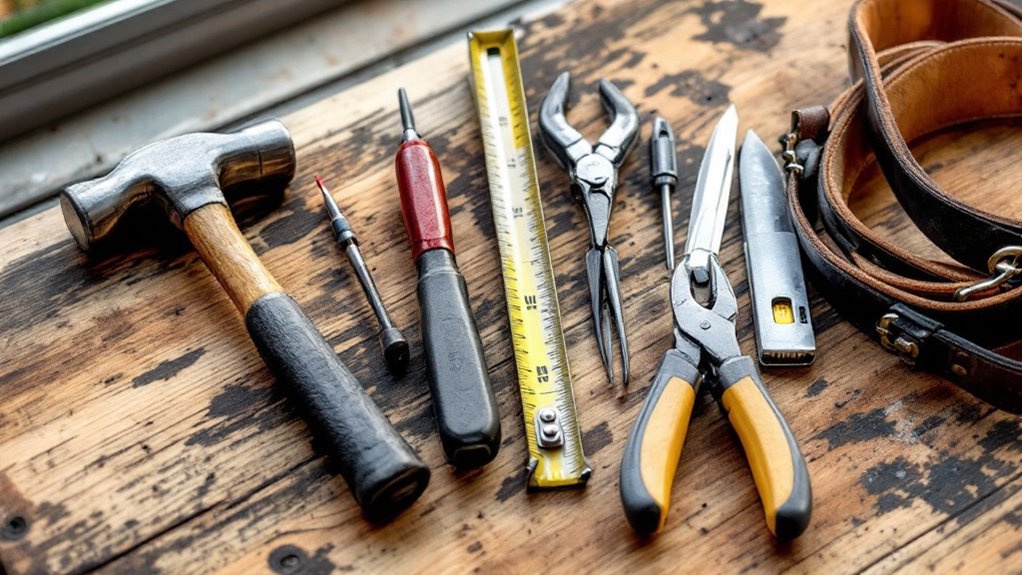I’ve learned through years of homeownership that having the right tools can mean the difference between a quick fix and an expensive service call. While I won’t pretend you need every gadget on the market, there’s a core set of tools that I consider essential for any homeowner. From basic repairs to weekend projects, these tools will help you maintain your investment and tackle common household challenges with confidence. Let me share what I’ve discovered about building a practical home toolkit that won’t break the bank but will prove invaluable when you need it most.
Power Drill and Drill Bits
A power drill stands out as the most essential tool in any homeowner’s arsenal. I’ve used mine for everything from hanging pictures to building entire decks, and let me tell you – once you’ve experienced the freedom from manual screwdrivers, there’s no going back.
You’ll want to invest in both corded and cordless options. A basic 20V cordless drill runs about $50-100, while professional-grade models can hit $200+. Think of it as your home’s Swiss Army knife – versatile, reliable, and always ready for action.
The real magic happens when you pair your drill with the right bits. I recommend starting with a basic set of twist bits ($15-30) for general drilling, some spade bits for larger holes, and both Phillips and flathead screwdriver bits.
Ever tried drilling into tile? You’ll need special ceramic bits for that dance.
Don’t skimp on quality here, fellow freedom lovers. A cheap drill bit is like a dull knife – it’ll make your work harder and potentially more dangerous. I learned this lesson the hard way when a bargain bit snapped mid-project.
Trust me, spending an extra $20 now saves frustration later.
Basic Hand Tools
Basic hand tools consistently form the backbone of any respectable toolkit, whether you’re fixing a leaky faucet or assembling furniture.
I’ve learned through countless DIY projects that you’ll want to invest in quality pieces that’ll last – think of them as your financial freedom from repairmen!
Start with the essentials: a sturdy hammer ($20-30), a set of screwdrivers ($25-40), and an adjustable wrench ($15-25).
I can’t tell you how many times these three have saved my bacon.
Add in a utility knife ($10), measuring tape ($8-15), and level ($15-20), and you’re cooking with gas.
Want to know my secret weapon? A multi-bit screwdriver ($30) that replaces an entire drawer of individual ones.
It’s like the Swiss Army knife of the tool world, and it’s saved me precious garage space and money.
Don’t fall for those bargain-bin tool sets – they’re about as reliable as a politician’s promise.
Instead, build your collection gradually with mid-range tools from reputable brands.
Trust me, your future self (and wallet) will thank you when that hammer’s still swinging true years down the road.
Measuring and Marking Equipment
Precise measurements mark the difference between a professional-looking project and an amateur mess. You wouldn’t build a house on guesswork, so why eyeball those shelf brackets or cabinet installations? Trust me, I’ve learned this lesson the hard way.
I always keep a 25-foot tape measure ($15-25) within arm’s reach – it’s like having a trusty sidekick that keeps you honest. For smaller measurements, a quality combination square ($20-30) is worth its weight in gold, helping you check those essential 90-degree angles and marking perfect lines.
Want to know what separates the weekend warriors from the pros? A laser level ($30-100). This little marvel of free-market innovation makes hanging pictures and installing chair rails a breeze.
Don’t forget about marking tools. I swear by my carpenter’s pencils (about $5 for a pack) and a good chalk line ($8-15). Ever tried drawing a straight line across a wall without one? It’s like trying to regulate a free market – unnecessarily complicated and bound to fail.
For ultimate precision, grab a digital caliper ($20-40); it’s perfect for those times when “close enough” just isn’t good enough.
Safety Gear
Now that you’re equipped to measure and mark with confidence, let’s talk about protecting yourself during those DIY adventures. As a liberty-loving DIY enthusiast, I know we’re not fans of excessive rules, but trust me – some basic safety gear is worth the investment.
Start with a solid pair of safety glasses ($10-20). I learned this lesson the hard way when a wood chip decided to play tag with my eyeball.
Good work gloves ($15-30) are next – I recommend mechanics-style gloves for dexterity and cut resistance. Ever tried picking up splintered wood bare-handed? Not fun.
Don’t skimp on respiratory protection. A pack of N95 dust masks runs about $20, while a half-face respirator ($30-40) is worth every penny for serious projects. Your lungs are like your personal property – protect them from unwanted intruders.
Last but essential: ear protection. Whether you choose basic foam plugs ($5/pack) or professional earmuffs ($20-30), your future self will thank you.
Plumbing Tools
When a leaky faucet strikes at midnight, you’ll want these plumbing essentials in your arsenal. Trust me, I’ve been there – standing in my basement at 2 AM, wondering why I didn’t invest in these basic tools sooner. Freedom from emergency plumber calls starts with self-reliance.
Let’s start with the holy trinity of plumbing tools: an adjustable wrench ($15-20), a set of tongue-and-groove pliers ($20-25), and a plunger ($10-15).
Why two types of gripping tools? Because nothing says “government overreach” quite like being forced to call a $200/hour plumber for a job you could’ve handled yourself.
A drain snake ($20-30) and plumber’s tape ($2-3) are your next must-haves. Think of the snake as your pipe’s personal liberator, breaking through clogs like a revolutionary through bureaucratic red tape.
And don’t forget a basin wrench ($15-20) – that awkward-looking tool is actually your best friend for accessing those tyrannically tight spots under sinks.
For serious DIY freedom fighters, I’d recommend adding a pipe wrench ($25-30) and a good set of seal picks ($10-15). They’ll pay for themselves after just one avoided service call.
Level and Straight Edge
Getting lines straight and angles right in your home projects comes down to having quality measuring tools on hand. I’ve learned through countless DIY disasters that a good level and straight edge are absolutely essential – they’re like a compass and map for your home improvement journey.
You’ll want to invest in three key tools:
- A 4-foot aluminum level ($25-35) for larger surfaces like walls and doors
- A torpedo level ($10-15) for tight spaces and plumbing work
- A sturdy metal straight edge ($20-30) at least 36 inches long
I can’t tell you how many times I’ve seen folks try to eyeball things, thinking they can judge what’s level by instinct. Trust me, your eyes will lie to you!
Think of a level as your project’s truth-teller – it doesn’t care about your ego or what you think looks right.
In my experience, spending a bit more on quality tools pays off. A cheap plastic level might save you $20 now, but it’ll cost you hours of frustration when that bookshelf ends up looking like it belongs in a funhouse.
Ladders and Support Equipment
From my years of DIY experience, I’ve learned that reliable ladders and support equipment are non-negotiable safety essentials.
Ever tried painting a ceiling while balanced on a rickety chair? Trust me, that’s a dance with gravity you don’t want to perform.
I recommend starting with a sturdy 6-foot A-frame ladder ($75-100) for indoor work and a solid extension ladder ($150-250) for those ambitious exterior projects.
Think of these as your vertical freedom machines – they’ll liberate you from the constraints of your earthbound existence.
Safety features matter more than brand names. Look for ladders with non-slip feet, secure locking mechanisms, and weight ratings at least 50% above your needs.
For support equipment, grab some solid sawhorses ($30-40 per pair) and a versatile scaffold platform ($100-150).
Don’t forget about ladder stabilizers ($25-40) – they’re like training wheels for your extension ladder, except they actually make you more capable rather than less.
And please, store your equipment properly. A ladder that’s been marinating in rain and rust is about as trustworthy as a politician’s promise.
Storage and Organization Solutions
A well-organized workshop isn’t just about looking tidy – it’s about maximizing efficiency and protecting your investment in tools.
I’ve learned through years of tinkering that having the right storage solutions can mean the difference between a smooth project and hours of frustrating searches for that one socket wrench.
Let me share my top storage essentials that’ll help you break free from workshop chaos:
- Pegboard system ($30-80): The ultimate freedom for your walls, letting you customize tool placement and rearrange as needed.
- Rolling tool chest ($100-500): Your mobile command center that keeps everything from getting lost in the government of gravity.
- Small parts organizer ($15-40): Those little bins are lifesavers for keeping screws, nuts, and washers from running their own rebellion.
I’ve found that modular storage systems give you the most flexibility to grow your collection without being locked into one configuration.
Remember, a cluttered workspace is like a restrictive government – it’ll slow you down and make everything harder than it needs to be.
Consider investing in clear containers too; they’re like having transparent policies in your workshop.
Lawn and Garden Tools
Every property owner needs reliable lawn and garden tools to maintain their outdoor space properly.
I’ve learned through years of trial and error that investing in quality tools upfront saves both money and headaches down the road.
Let’s start with the essentials: a durable spade ($30-50), garden rake ($20-30), and leaf rake ($15-25).
Think of these as your outdoor trinity – they’ll handle 80% of your basic yard work needs.
Don’t forget a good pair of pruning shears ($25-40); they’re like scissors for your shrubs!
For larger properties, I strongly recommend a wheelbarrow ($80-150) – your back will thank you later.
And while those fancy ergonomic tools might look tempting, I’ve found that simple, well-made implements often outlast their gimmicky counterparts.
What about power tools?
A decent electric string trimmer ($100-200) and leaf blower ($90-180) will serve most homeowners well.
You might be tempted by gas-powered versions, but unless you’re maintaining acres of land, electric models offer plenty of freedom without the maintenance hassle.
Conclusion
I’ve learned that having the right tools isn’t just about fixing things – it’s about taking control of your home’s destiny. With a well-stocked toolkit that’ll save you millions in repairs (okay, maybe not millions), you’ll tackle projects with confidence and pride. Trust me, there’s nothing quite like the satisfaction of solving problems yourself. Ready to get started? Your DIY journey begins with these essential tools.

